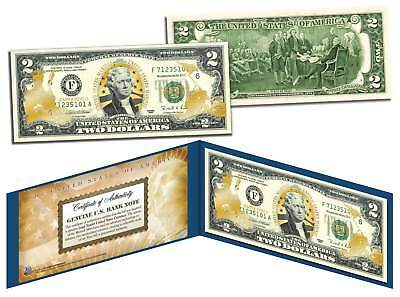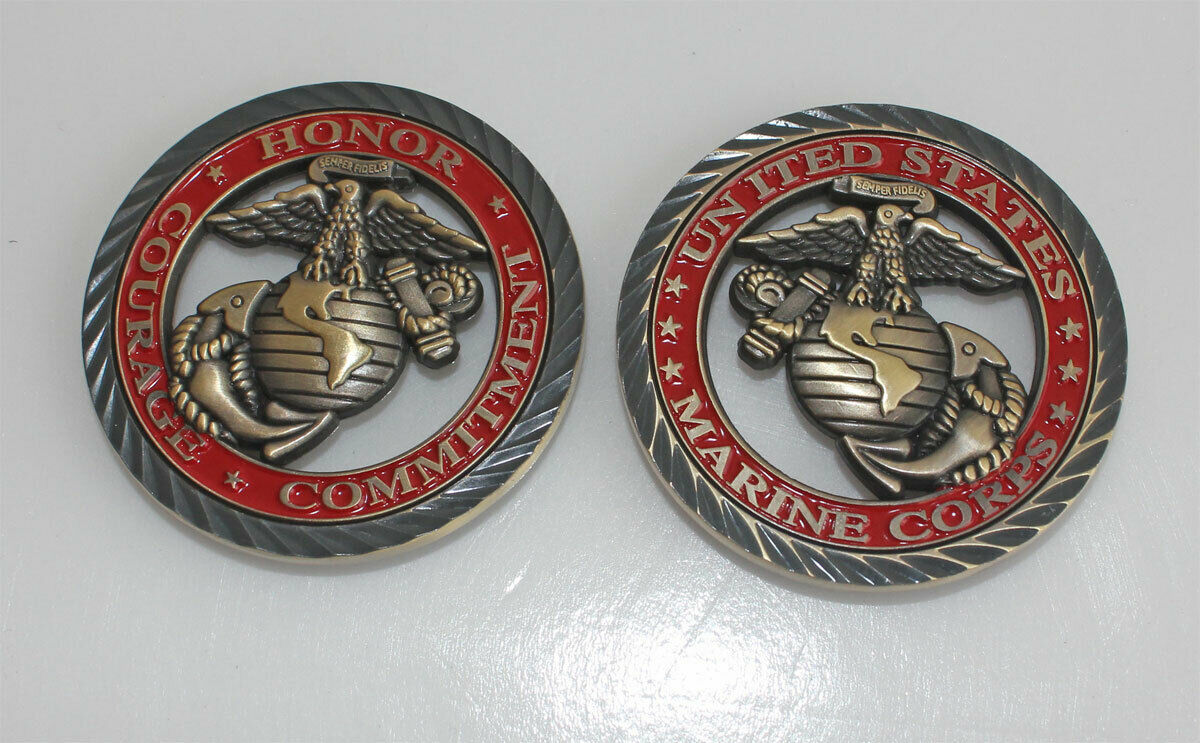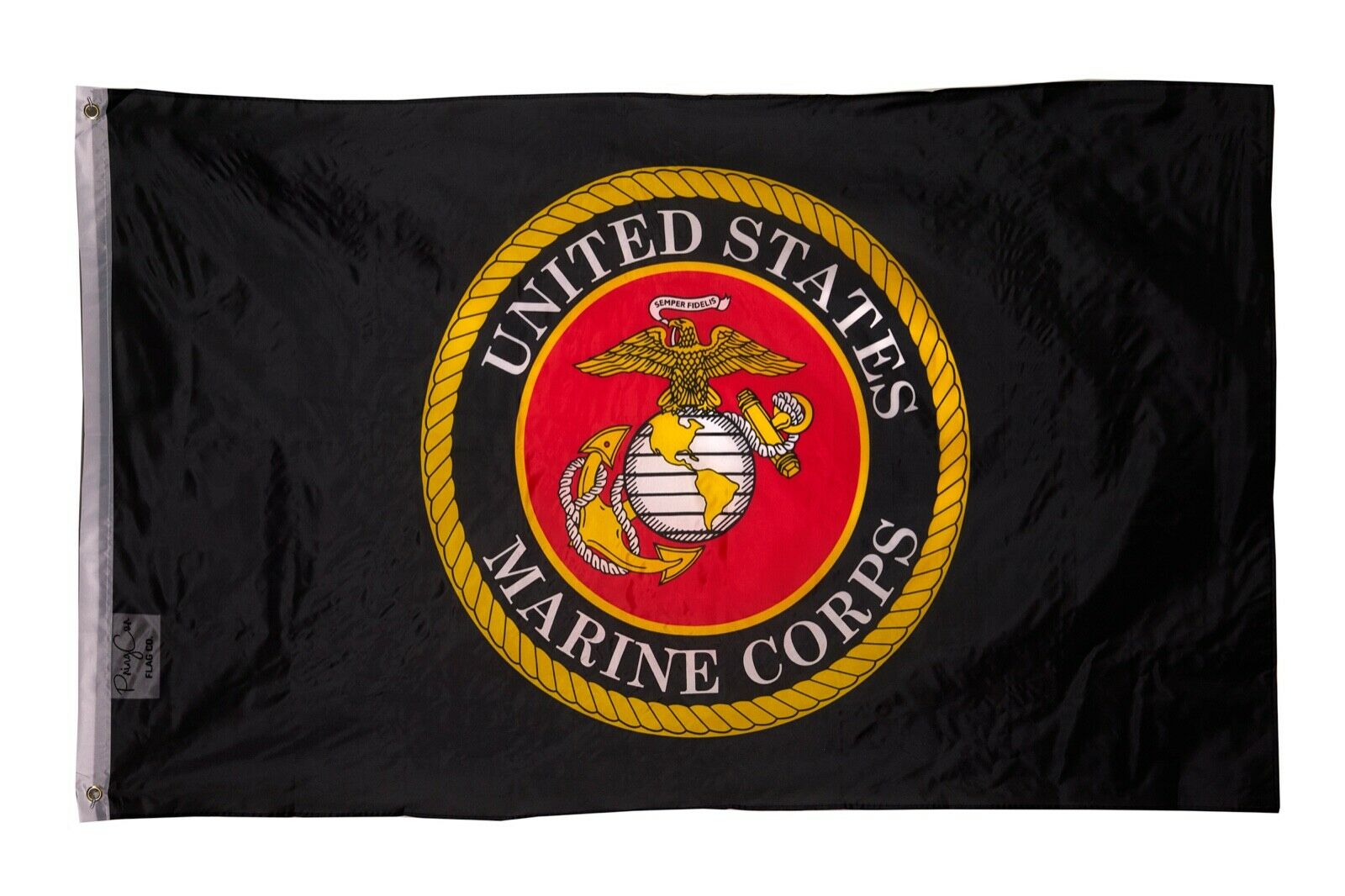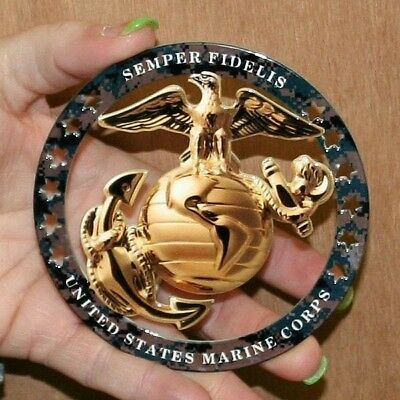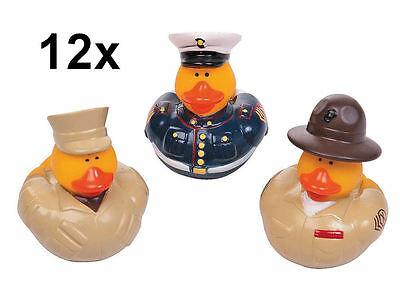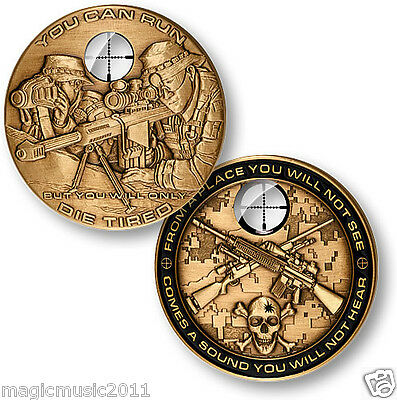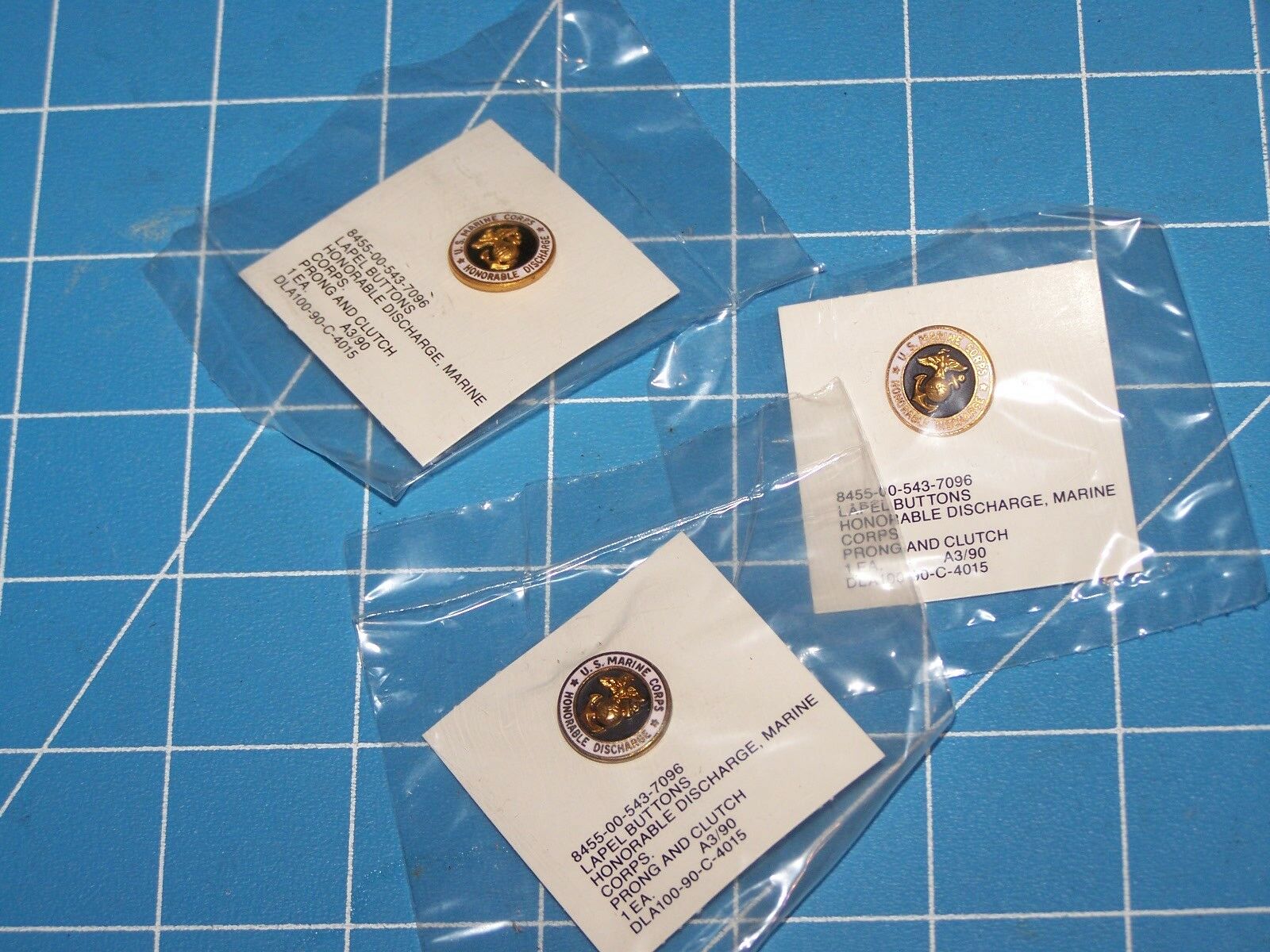-40%
5 photo UNITED STATES MARINE BAND MUSICIANS & DRUM & BUGLE CORPS USMC
$ 23.76
- Description
- Size Guide
Description
4 - 8" X 10" & 1 - 7" X 5" GLOSSY PHOTOGRAPHS OF MARINE MUSICIANS. Excellent condition. Caption on reverse of 2 photos "Watch Your Credit - Official Marine Corps Photograph". 1). Group of Marine Bandsmen - Identification on Drum - FMF PAC Drum and Bugle Team. 2). Looks like the same group performing on the Parade Deck. 3). Band Marching. 4). FMF PAC Drum & Bugle Team in Dress Blues. This one is signed by 20 of the Team Members. & 5). Several Bandsmen standing among and talking to a group of young children. First Class Mail USPS delivery in the Continental US is $ 5.00. Will ship Worldwide and will combine shipping when practical.Lore of the Corps
Starting in boot camp, all Marines study the actions of those who have served before them. The history of the Marine Corps is a rich tapestry weaving together the contributions of all Marines. Over the past two centuries, certain aspects of the Corps’ history have taken on an almost legendary status. Below are examples of some of the stories, terms, and traditions that have come to be known as the “Lore of the Corps.”
The
The Blood Stripe
Marine Corps tradition maintains that the red stripe worn on the trousers of officers and noncommissioned officers, and commonly known as the “blood stripe,” commemorates those Marines killed storming the castle of Chapultepec in 1847. Although this belief is firmly embedded in the traditions of the Corps, it has no basis in fact. The use of stripes clearly predates the Mexican War.
In 1834, uniform regulations were changed to comply with President Andrew Jackson’s wishes that Marine uniforms return to the green and white worn during the Revolutionary War. The wearing of stripes on the trousers began in 1837, following the Army practice of wearing stripes the same color as uniform jacket facings. Colonel Commandant Archibald Henderson ordered those stripes to be buff white. Two years later, when President Jackson left office, Colonel Henderson returned the uniform to dark blue coats faced red. In keeping with earlier regulations, stripes became dark blue edged in red. In 1849, the stripes were changed to a solid red. Ten years later uniform regulations prescribed a scarlet cord inserted into the outer seams for noncommissioned officers and musicians and a scarlet welt for officers. Finally, in 1904, the simple scarlet stripe seen today was adopted.
"Leatherneck"
In 1776, the Naval Committee of the Second Continental Congress prescribed new uniform regulations. Marine uniforms were to consist of green coats with buff white facings, buff breeches and black gaiters. Also mandated was a leather stock to be worn by officers and enlisted men alike. This leather collar served to protect the neck against cutlass slashes and to hold the head erect in proper military bearing. Sailors serving aboard ship with Marines came to call them “leathernecks.”
Use of the leather stock was retained until after the Civil War when it was replaced by a strip of black glazed leather attached to the inside front of the dress uniform collar. The last vestiges of the leather stock can be seen in today’s modern dress uniform, which features a stiff cloth tab behind the front of the collar.
The term “leatherneck” transcended the actual use of the leather stock and became a common nickname for United States Marines. Other nicknames include “soldiers of the sea,” “devil dogs,” and the slightly pejorative “gyrene,” (a term which was applied to the British Royal Marines in 1894 and to the U.S. Marines by 1911), and “jarhead.”
Semper Fidelis
"Semper Fidelis"
The Marine Corps adopted the motto “Semper Fidelis” in 1883. Prior to that date three mottoes, all traditional rather than official, were used. The first of these, antedating the War of 1812, was “Fortitudine.” The Latin phrase for “with courage,” it was emblazoned on the brass shako plates worn by Marines during the Federal period. The second motto was “By Sea and by Land,” taken from the British Royal Marines “Per Mare, Per Terram.” Until 1848, the third motto was “To the shores of Tripoli.” Inscribed on the Marine Corps colors, this commemorated Presley O’Bannon’s capture of the city of Derna in 1805. In 1848, this was revised to “From the halls of the Montezuma to the shores of Tripoli.”
“Semper Fidelis” signifies the dedication that individual Marines have to “Corps and country,” and to their fellow Marines. It is a way of life. Said one former Marine, “It is not negotiable. It is not relative, but absolute…Marines pride themselves on their mission and steadfast dedication to accomplish it.”
"Devil Dogs"
Picture
According to Marine Corps tradition, German soldiers facing the Marines at Belleau Wood called them teufelhunden. These were the devil dogs of Bavarian folklore - vicious, ferocious, and tenacious. Shortly thereafter, a Marine recruiting poster depicted a dachshund, wearing an Iron Cross and a spiked helmet, fleeing an English bulldog wearing the eagle, globe and anchor.
A tradition was born. Although an “unofficial mascot,” the first bulldog to “serve” in the United States Marine Corps was King Bulwark. Renamed Jiggs, he was enlisted on 14 October 1922 for the “term of life.” Enlistment papers were signed by Brigadier General Smedley D. Butler. Although he began his career as a private, Jiggs was quickly promoted to the rank of sergeant major. His death at the age of four was mourned throughout the Corps. His body lay in a satin-lined casket in a hangar on Marine Corps Base Quantico until he was buried with military honors.
Other bulldogs followed in the tradition of Jiggs. From the 1930s through the early 1950s, the name of the bulldogs was changed to Smedley as a tribute to Major General Butler. In the late 1950s, the Marine Barracks in Washington became the new home for the Marine Corps’ bulldog. Chesty, named in honor of the legendary Lieutenant General Lewis B. “Chesty” Puller, Jr, made his first public appearance on 5 July 1957.
Today the tradition continues. The bulldog, tough, muscular and fearless, has come to epitomize the fighting spirit of the United States Marine Corps.
8th and I
Picture
A notice posted in the Washington newspaper National Intelligence on 3 April 1801 offered “a premium of 100 dollars” for the “best plan of barracks for the Marines sufficient to hold 500 men, with their officers and a house for the Commandant.” The site for the barracks, near the Washington Navy Yard and within marching distance of the Capitol, was chosen by President Thomas Jefferson, who rode through Washington with Lieutenant Commandant William W. Burrows.
The competition was won by George Hadfield, who laid out the barracks and the house in a quadrangle. The barracks were established in 1801, the house, home of the Commandant of the Marine Corps, was completed in 1806. It is the oldest public building in continuous use in the nation’s capital.
Marine Corps traditions holds that when Washington was burned by the British during the War of 1812, both the Commandant’s House and the barracks were spared out of respect for the bravery shown by Marines during the Battle for Bladensburg.
Today, 8th and I is home to one of the most dramatic military celebrations in the world -- The Evening Parade. Held every Friday evening from May through August, the Evening Parade features “The President’s Own” United States Marine Band, “The Commandant’s Own” The United States Marine Drum and Bugle Corps, and the Marine Corps Silent Drill Platoon. It has become a lasting symbol of the professionalism, discipline, and esprit de Corps of the United States Marines, a celebration of the pride taken in a history that spans more than 230 years.
The Eagle, Globe and Anchor
Eagle, Globe and Anchoe
The origins of the eagle, globe, and anchor insignia worn by Marines can be traced to those ornaments worn by early Continental Marines as well as to the British Royal Marines.
In 1776, Marines wore a device depicting a fouled anchor. Changes were made to that device in 1798, 1821, and 1824. An eagle was added in 1834. The current insignia dates to 1868 when Brigadier General Commandant Jacob Zeilin convened a board “to decide and report upon the various devices of cap ornaments of the Marine Corps.” A new insignia was recommended and approved by the Commandant. On 19 November 1868, the new insignia was accepted by the Secretary of the Navy.
The new emblem featured a globe showing the western hemisphere intersected by a fouled anchor and surmounted by an eagle. Atop the device, a ribbon was inscribed with the Latin motto “Semper Fidelis.” The globe signified the service of the United States Marines throughout the world. The anchor was indicative of the amphibious nature of the Marine Corps. The eagle, symbolizing a proud nation, was not the American bald eagle, but rather a crested eagle, a species found throughout the world.
On 22 June 1954, President Dwight D. Eisenhower signed an Executive Order which approved the design of an official seal for the United States Marine Corps. Designed at the request of General Lemuel C. Shepherd, Jr., Commandant of the Marine Corps, the seal replaced the crested eagle with the American bald eagle, its wings proudly displayed. With the approval of this seal by the President of the United States in 1955, the emblem centered on the seal was adopted as the official Marine Corps emblem.
The eagle, globe, and anchor insignia is a testament to the training of the individual Marine, to the history and traditions of the Marine Corps, and to the values upheld by the Corps. It represents “those intangible possessions that cannot be issued: pride, honor, integrity, and being able to carry on the traditions for generations of warriors past.” Said retired Sergeant Major David W. Sommers, “the emblem of the Corps is the common thread that binds all Marines together, officer and enlisted, past and present…The eagle, globe and anchor tells the world who we are, what we stand for, and what we are capable of, in a single glance.”
The Marine Hymn
Following the Barbary Wars of 1805, the Colors of the Corps were inscribed with the words “to the shores of Tripoli.” After the capture and occupation of Mexico City in 1847, the Colors were changed to read “from the shores of Tripoli to the Halls of Montezuma.” These events in Marine Corps history are the origin of the opening words of the Marines’ Hymn.
Tradition holds that the words to the Marines’ Hymn were written by a Marine serving in Mexico. In truth, the author of the words remains unknown. Colonel Albert S. McLemore and Walter F. Smith, Assistant Band Director during the John Philip Sousa era, sought to trace the melody to its origins. It was reported to Colonel McLemore that by 1878 the tune was very popular in Paris, originally appearing as an aria in the Jacques Offenbach opera Genevieve de Brabant. John Philips Sousa later confirmed this belief in a letter to Major Harold Wirgman, USMC, stating “The melody of the ‘Halls of Montezuma’ is taken from Offenbach’s comic opera...”
Its origins notwithstanding, the hymn saw widespread use by the mid-1800s. Copyright ownership of the hymn was given to the Marine Corps per certificate of registration dated 19 August 1891. In 1929, it became the official hymn of the United States Marine Corps with the verses shown on the right.
On 21 November 1942, the Commandant of the Marine Corps authorized an official change in the first verse, fourth line, to reflect the changing mission of the Marine Corps. The new line read "in the air, on land and sea." That change was originally proposed by Gunnery Sergeant H.L. Tallman, an aviator and veteran of World War I.
Shortly after World War II, Marines began to stand at attention during the playing of The Marines’ Hymn, Today that tradition continues today to honor all those who have earned the title "United States Marine."
00:0000:00
The Marines' Hymn
From the Halls of Montezuma
to the Shores of Tripoli,
We fight our country’s battles
On the land as on the sea.
First to fight for right and freedom,
And to keep our honor clean,
We are proud to claim the title
of United States Marine.
"Our flag’s unfurl’d to every breeze
From dawn to setting sun;
We have fought in every clime and place
Where we could take a gun.
In the snow of far-off northern lands
And in sunny tropic scenes,
You will find us always on the job
The United States Marines.
"Here’s health to you and to our Corps
Which we are proud to serve;
In many a strife we’ve fought for life
And never lost our nerve.
If the Army and the Navy
Ever look on Heaven’s scenes,
They will find the streets are guarded
By United States Marines."
The United States Marine Band is the premier band of the United States Marine Corps. Established by act of Congress on July 11, 1798, it is the oldest of the United States military bands and the oldest professional musical organization in the United States. Today, the Marine Band also includes the Marine Chamber Orchestra and Marine Chamber Ensembles.
The Marine Band is entirely separate from its sister military band, the United States Marine Drum and Bugle Corps ("The Commandant's Own") and the 10 active duty Marine Corps field bands.
The Marine Band has been uniquely known as "The President's Own" since 1801 due to the historic connection to the President of the United States. The relationship between the Marine Band and the White House began on New Year's Day 1801, when President John Adams invited the band to perform at the Executive Mansion. Later that year, Thomas Jefferson initiated the tradition of Marine Band performances by requesting that it perform at his inauguration. The Marine Band has played at every United States presidential inauguration since. President Thomas Jefferson gave the title "The President's Own" in 1801. This terminology emulated a long-established British usage, where various military units were designated as "King's Own" or "Queen's Own".
Today, the Marine Band performs in approximately 500 events every year[1][non-primary source needed] including state funerals, state arrival ceremonies, state dinners, parades, concerts, and other social events. The Marine Band also travels across the country each October and November during its fall concert tour, a tradition that began in 1891 under its most famous director, composer John Philip Sousa.
Contents
1
Members and organization
2
Performances
3
Leadership
4
Composers
5
Music
6
Gallery
7
See also
8
Notes
9
Further reading
10
External links
Members and organization
United States Marine Band uniforms
The Marine Band recruits experienced musicians; members are selected through a rigorous audition procedure and must satisfy additional security and physical requirements to be eligible. Selected band members serve under a four-year contract as active duty enlisted Marines and are subject to the Uniform Code of Military Justice and physical standards. Members of The President's Own and the United States Coast Guard Band are the only members of the United States Armed Forces not required to undergo recruit training and do not perform combat missions. Also, they are not assigned to any unit other than the Marine Band. Musicians of other Marine bands are required to attend boot camp and Marine Combat Training (MCT).
The 'President's Own' band members start at the rank of Staff Sergeant, and wear rank insignia with a lyre replacing the normal crossed rifles. Commissioned officers are often drawn from within the band, although auditions are open to members of all Marine Corps bands. Drum majors are career Marines and are selected from the Marine Corps field bands, as they are responsible for the military development of the band's members. As of 2010, the USMC spends about million annually to support the band.[2]
In 2005, Sara Sheffield became the first female feature vocalist in the band's history.[3]
Performances
The Marine Band marching down 15th Street during an inaugural parade held in honor of President Bill Clinton on January 20, 1997
Members of the Marine Band escorting the remains of President Ronald Reagan to the Capitol Rotunda during his state funeral held in June 2004
The Marine Band performing for an audience attending a wreath laying ceremony honoring the United States Marine Corps' 229th birthday at the Marine Corps War Memorial
The Marine Band's performance schedule is coordinated by the Marine Band Branch of Headquarters Marine Corps Public Affairs, which works with the Director of the Marine Band and the Marine Band Operations Office to schedule performances and ceremonies by the band, chamber orchestra, and chamber ensembles.
The Marine Band also has a professional support staff (Library, Recording Lab, Stage Managers, and Stage Crew) as well as the Administration, Public Affairs, and Supply offices, who work to coordinate, promote, and facilitate performances throughout the year.
The full band has a complement of about 130 members, although they all play together only rarely.
A 42-piece band is used for all Pentagon and formal military arrivals and patriotic openers for large events. Patriotic openers are 15 minutes of patriotic music, including the presentation and retirement of the colors, "The Star-Spangled Banner" (national anthem), and the "Marines' Hymn". Patriotic openers are performed throughout the Washington metropolitan area at a variety of events for military organizations, federal agencies, and associations.
Events that the Marine Band participates in include:
United States presidential inaugurations. The Marine Band has participated in every presidential inauguration since Thomas Jefferson's in 1801. The Marine Band is positioned at the United States Capitol for the swearing-in ceremony, and a 99-piece band marches in the inaugural parade back to the White House. The band also performs for celebrations following the official ceremony and parade. Celebrations are typically divided by state and held at hotels and in large public spaces throughout Washington D.C.
State funerals. The Military District of Washington Commander of Troops arranges the ceremonial preparations and, for the funeral, supervises the procession to the Washington National Cathedral in Northwest D.C. The Secretary of Defense conducts the funeral proceedings. A traditional component of the state funeral is a procession composed of National Guard, active-duty, academy, and reserve personnel that represent the five branches of the United States armed forces. A 99-piece band provides traditional music during each phase of the state funeral, often with other military bands. Previous funeral processions in the nation's capital have honored ten presidents.
State Arrival Ceremonies. The Marine Band performs during a State Arrival Ceremony at the White House, an event which welcomes a visiting head of state to the United States and begins a state visit. The United States Marine Band is located on the balcony of the South Portico, just outside the Blue Room. Following the ceremony, the Marine Band performs in the Cross Hall during the receiving line and reception.
Arlington National Cemetery military funerals. The Marine Band participates in every full honors military funeral for a deceased Marine at Arlington National Cemetery. During the funeral ceremony, the Marine Band performs chorales and hymns on every occasion that the deceased is transferred or moved. When the escorts and funeral procession move the deceased from a chapel or transfer site to the final resting place, a drum cadence and funeral marches are performed. "Marines' Hymn" is performed for the final transfer of the deceased onto the resting site. Following this, the deceased receives final honors and three volleys, and a lone bugler from the Marine Band performs "Taps". At the conclusion of the funeral ceremony, an American flag is folded and presented to the family of the deceased, during which the Marine Band performs "Eternal Father, Strong to Save", the Navy hymn.
Friday Evening Parades are held at Marine Barracks, Washington, D.C. during Friday evenings in summer (May through August). These 75-minute performances of music and precision marching, features the Marine Band along with the Drum and Bugle Corps, and the Silent Drill Platoon. The ceremony begins at 8:45 pm, with a concert by the Marine Band.
Other events. The Marine Band sometimes performs at additional events, such as state dinners and formal receptions at the White House, as well as performances at the National Sylvan Theater in Washington D.C. during the summer months.
Leadership
Violinist from the Marine Band performing during a reception at the residence of the Commandant of the Marine Corps on July 19, 2013
Drum Major of the United States Marine Band, Master Sergeant William L. Browne, wearing a bearskin headpiece and holding a ceremonial mace
Jason Fettig during the inauguration of Joe Biden
The early leadership of the Marine Band consisted of both a Drum Major and a Fife Major, who wore identical uniforms. The Drum Major was considered the Leader of the Marine Band, while the Fife Major's responsibility was to train the fifers. The first leader of the United States Marine Band was William Farr, who is listed in historical records as having served as Drum Major from January 21, 1799.
After the retirement of Drum Major Raphael Triay in 1855, then-Fife Major Francis Scala became Drum Major. On July 25, 1861, President Abraham Lincoln signed an Act of Congress to reorganize the Marine Band. This act abolished the rank of Fife Major (and in 1881 the fife was removed from Marine Corps instrumentation entirely), created the positions of Leader of the Band/Principal Musician, Drum Major, and authorized 30 musicians. Scala was the first Marine Band musician to receive the title "Leader of the Band"; John Roach was selected as Drum Major.
The earliest recorded Second Leader of the United States Marine Band was Salvador Petrola. Marine Band cornetist Walter F. Smith, who had performed under 17th director, John Philip Sousa, became the first official Second Leader when an Act of Congress established the positions of First Leader and Second Leader of the Marine Band in March 1899.
Many changes took place during the Dwight D. Eisenhower administration. The titles First Leader and Second Leader were replaced by Director and Assistant Director. When Albert F. Schoepper was appointed as Director in 1955, a second Assistant Director was added to the Marine Band leadership. Today, the Assistant Director positions are designated in two titles: Senior Assistant Director and Executive Officer, and Assistant Director. It is also during the Eisenhower administration that the first "Soloist and Moderator" was appointed. William D. Jones, known as the original soloist with the new US Air Force Band and originator and director of the Singing Sergeants, was transferred by an Act of Congress to the USMC Band and given the title "Ambassador of Music".[4] The Soloist and Moderator served as the senior enlisted member until 1972, when Schoepper and Jones retired.
Today, the Drum Major serves as the senior enlisted member of "The President's Own" and is responsible for the band's appearance, ceremonial drill, and military decorum. He is charged with directing the band in ceremonies, including the inaugural parade, and regularly leads the band in review for presidents and visiting heads of state and other dignitaries.
The Drum Major's wears a bearskin headpiece and carries a ceremonial mace used to signal commands to the musicians. The drum major also wears the officer's version of the Eagle, Globe, and Anchor (the Marine Corps emblem). He also wears an ornate baldric, similar to a sash, embroidered with the band's crest and the Marine Corps' battle honors, as well as miniatures of his own medals.
Composers
Sousa composed several of his finest marches, including Semper Fidelis, while serving as director of the Marine Band.[5]
Thomas Powell Knox joined the Marine Band in 1961 as a trumpet player and moved to the arranging staff in 1966. Three years later, Knox was appointed chief arranger and continued to compose and arrange for the Marine Band until his retirement in 1985. Some of his more notable compositions include "God of Our Fathers" (commissioned for Ronald Reagan's first inauguration) and "American Pageant", which was commissioned for Richard Nixon's first inauguration. Knox arranged or composed over 300 pieces, many of which are still played by the Marine Band and other bands across America.
The United States Marine Drum & Bugle Corps is the drum and bugle corps of the United States Marine Corps. The D&B is now the only full-time active duty drum corps in the United States Armed Forces. As one of many United States military bands, the United States Marine Drum & Bugle Corps consists of 80 active-duty Marines dressed in ceremonial red and white uniforms. The D&B performs martial and popular music.[1]
The United States Marine Drum & Bugle Corps has been officially designated as "The Commandant's Own" due to the historical connection with the Commandant of the Marine Corps. The D&B is entirely separate from its sister military band, the United States Marine Band ("The President's Own") as well as the 10 active-duty United States Marine Corps field bands. The United States Marine Drum & Bugle Corps travels more than 50,000 miles (80,000 km) annually, performing in excess of 400 events across the United States and around the world.
During the summer months, the D&B performs in conjunction with "The President's Own" in the traditional Friday Evening Parades at the Marine Barracks Washington and in the Sunset Parades at the Marine Corps War Memorial (Iwo Jima Monument) in Arlington, Virginia, every Tuesday evening. The parades are not street parades, but military parades consisting of ceremonial pomp that are symbolic of Marine professionalism, discipline, and esprit de corps.[2]
Major James D. Foley is the sixth and current director of "The Commandant's Own" The United States Drum & Bugle Corps, serving in this position since July 2018. Captain Nathan Morris is the Executive Officer and Assistant Director. Master Gunnery Sergeant Keith G. Martinez is the twenty-second and current Drum Major. Gunnery Sergeant Joshua Dannemiller is the current Assistant Drum Major.[1]
Contents
1
History
2
Training
3
Uniforms and instruments
4
See also
5
References
6
External links
History
"The Commandant's Own" The United States Marine Drum & Bugle Corps with then President George W. Bush while in France.
The history of the unit can be traced to the early days of the Marine Corps. In the 18th and 19th centuries, military musicians ("field musics") provided a means of passing commands to Marines in battle. The sound of various drum beats and bugle calls that could be heard over the noise of the battlefield signaled Marines to attack the enemy or retreat. Through the 1930s, Marine Corps posts still authorized a number of buglers and drummers to play the traditional calls and to ring a ship's bell to signal the time. Until the 1960s, Marine Corps units sported unit drum and bugle corps within their respective rosters.
"The Commandant's Own" The United States Marine Drum & Bugle Corps, the only such formation within the Armed Forces today, was formed in 1934 at historic Marine Barracks Washington, to augment the United States Marine Band "The President's Own". The unit provided musical support to ceremonies around the nation's capital and, during World War II, was additionally tasked with presidential support duties. For this additional role, they were awarded the scarlet and gold breast cord by President Franklin Delano Roosevelt, which remains on the uniform. When the war ended, the United States Drum and Bugle Corps resumed performing at various military and public ceremonies.
In the early 1950s, the unit gained considerable acclaim performing for an increasing number of civilian audiences. Originally their instrumentation was similar to the other drum and bugle corps of the era. It has evolved along with the civilian corps, although usually adapting trends after they have become established by civilian corps. Music composed specifically for their unique selection of instruments helped establish their reputation for excellence during this period. These factors also led to the unit's formal designation as "The Commandant's Own", a title noting their special status as musicians for the Commandant of the Marine Corps.
In 1968, Truman Crawford, formerly of the United States Air Force Drum and Bugle Corps became musical arranger and instructor for The Commandant's Own. During his 30-year career he had a large impact on the D&B comparable to that of John Philip Sousa on the United States Marine Band. The new rehearsal facility of "The Commandant's Own" at Marine Barracks Washington, is named Truman Crawford Hall in his honor.[3]
Training
External video
video icon Behind the Scenes: Drum Major Auditions
Like the United States Marine Band, prior to enlisting each potential member of the Drum and Bugle Corps, all must pass a competitive audition. Unlike members of the President's Own, Drum and Bugle Corps members do undergo Marine Corps Recruit Training, where they are trained in basic infantry tactics.[4]
Following Recruit Training and Marine Combat Training, Drum and Bugle Corps members proceed directly to "The Commandant's Own" and do not attend Military Occupational Specialty training. The United States Marine Drum and Bugle Corps does not march in parades of state, but instead is held back in reserve by the Commandant of the Marine Corps who may order it anywhere since the corps serves under the Commandant's immediate command.[1][2]
Uniforms and instruments
See also: Uniforms of the United States Marine Corps
The field musicians of the United States Marine Drum & Bugle Corps wear red and white uniforms with white gauntlets which cover the wrists and bear and play silver color brass instruments.
Master Sergeant Kevin D. Buckles, former Drum Major of the United States Marine Drum & Bugle Corps "The Commandant's Own" holding a ceremonial mace.
The brass played by "The Commandant's Own" are bugles pitched in G. Additionally, their bugles are two-valved models similar to those used by drum corps in the United States and Canada prior to 1990. The D&B's current inventory of brass instrumentation was manufactured by the Kanstul Musical Instruments company in 2006.[1]






